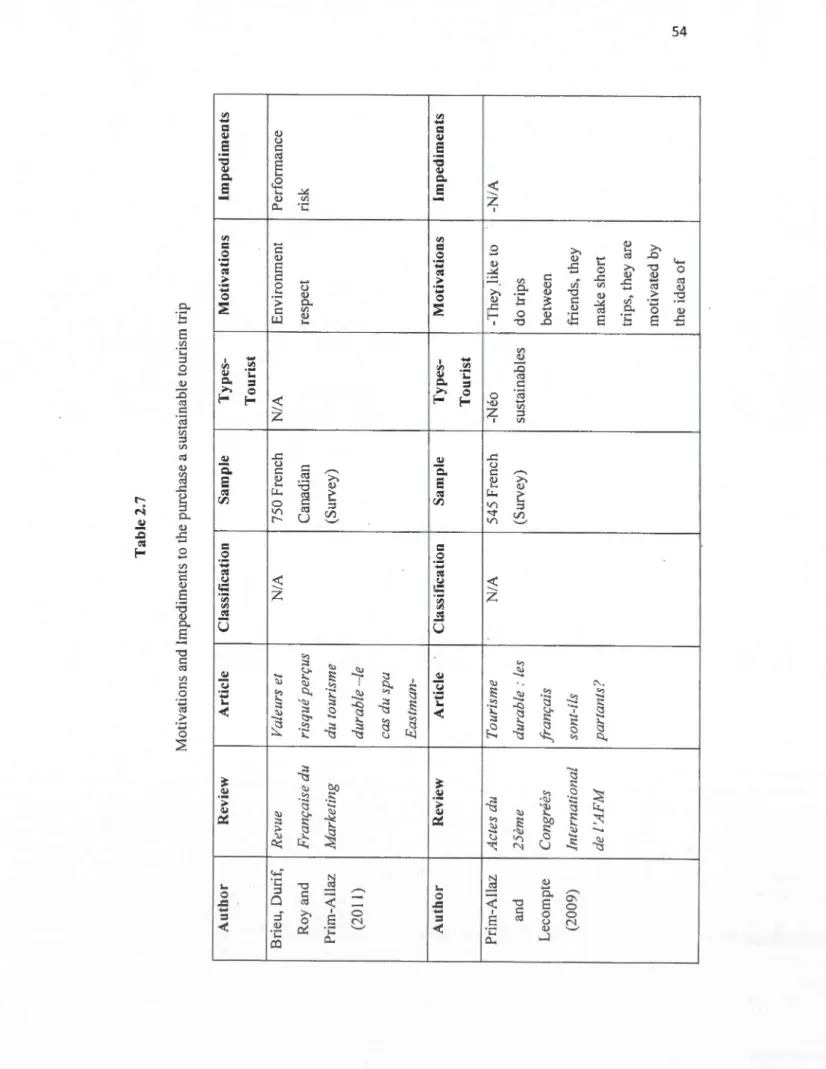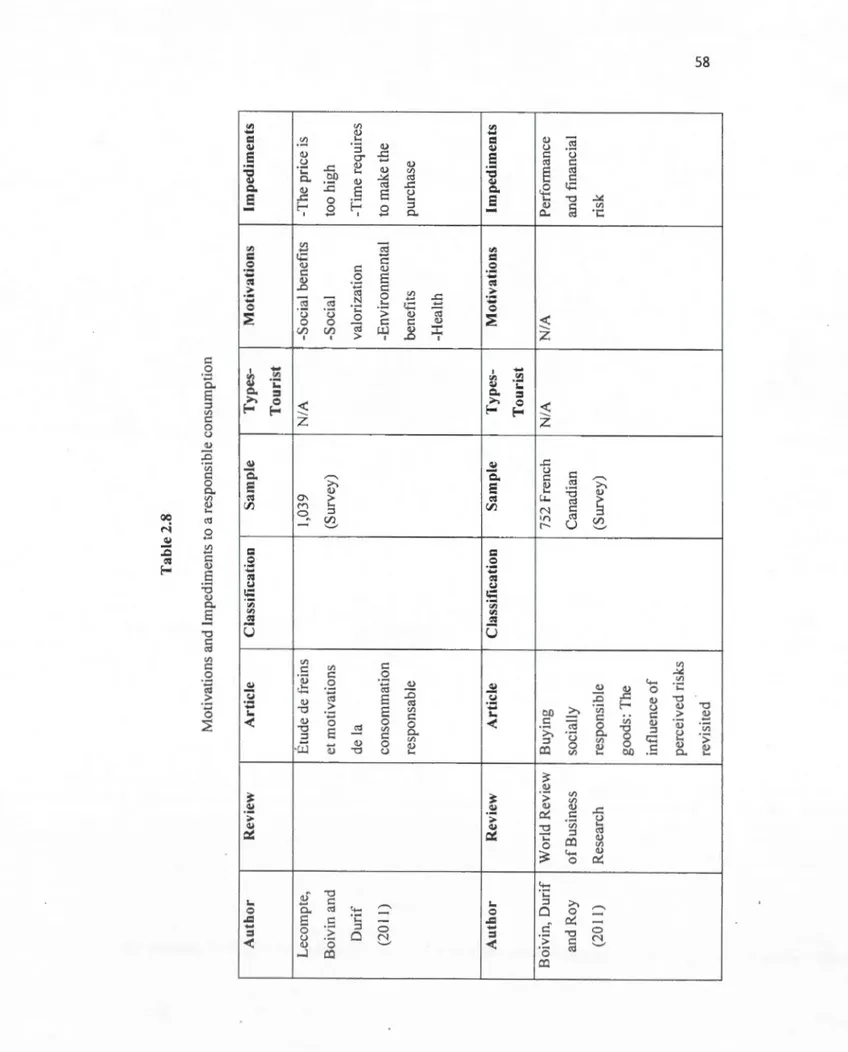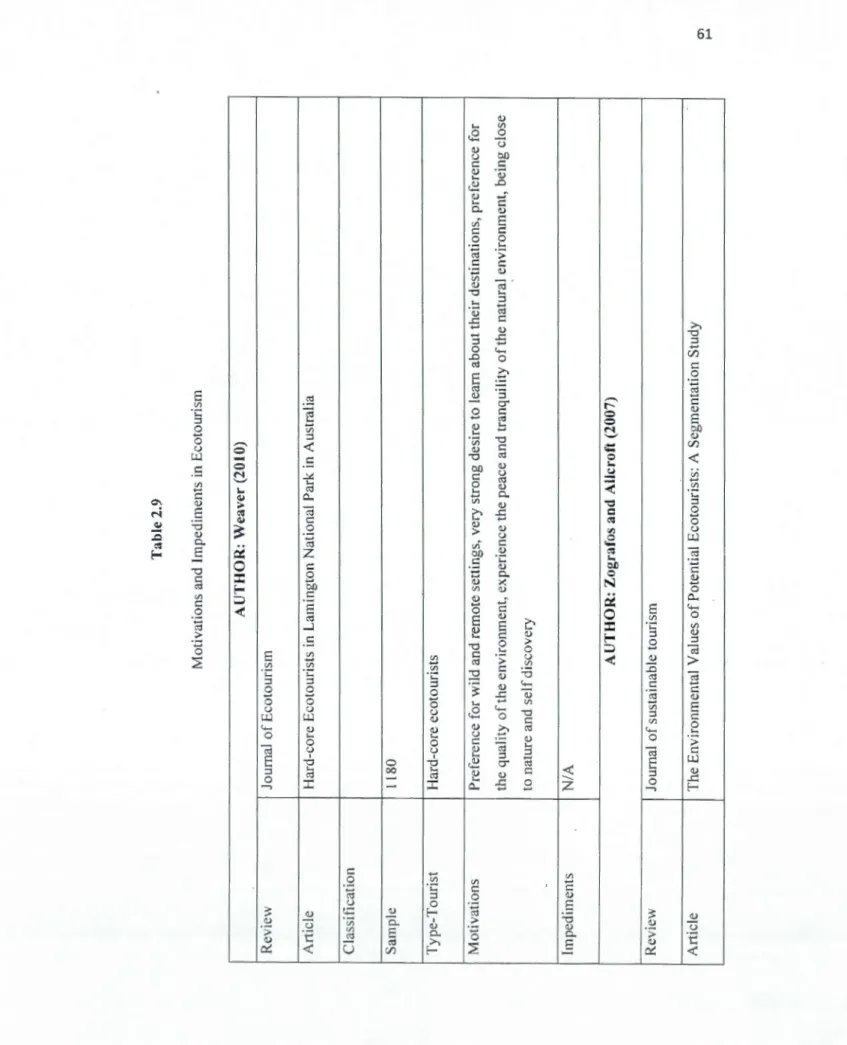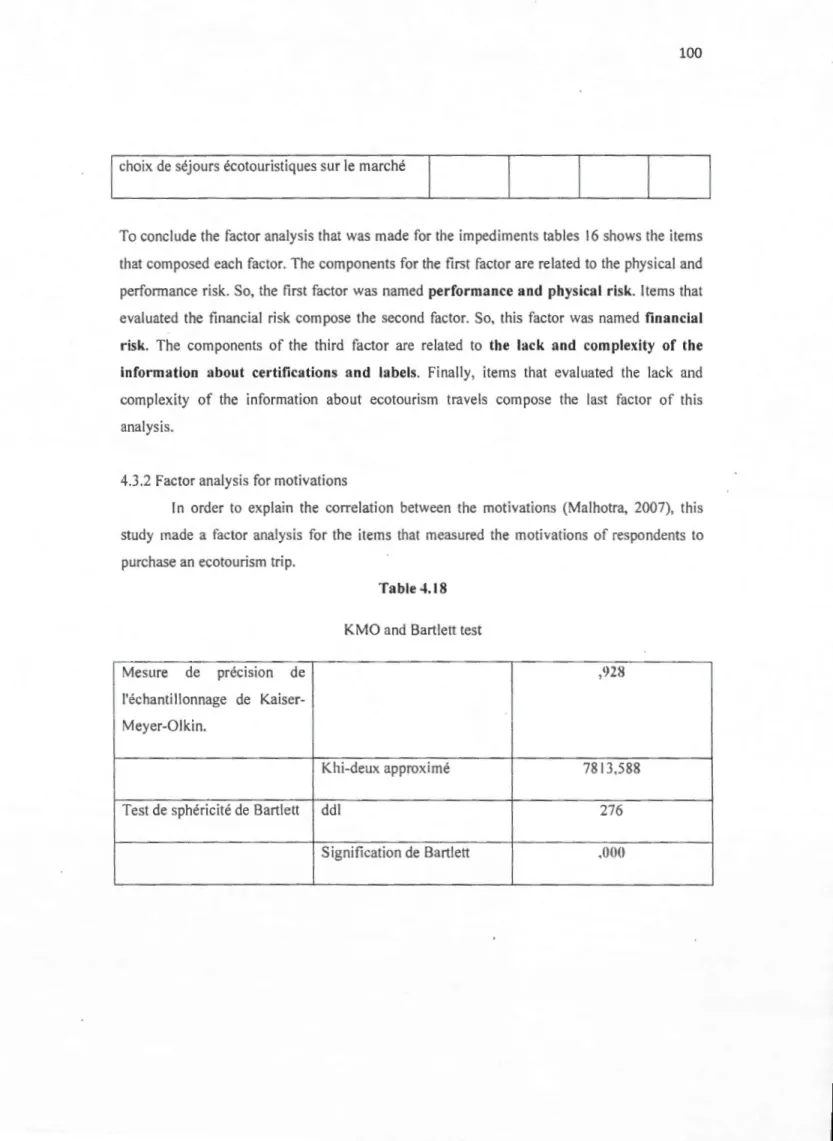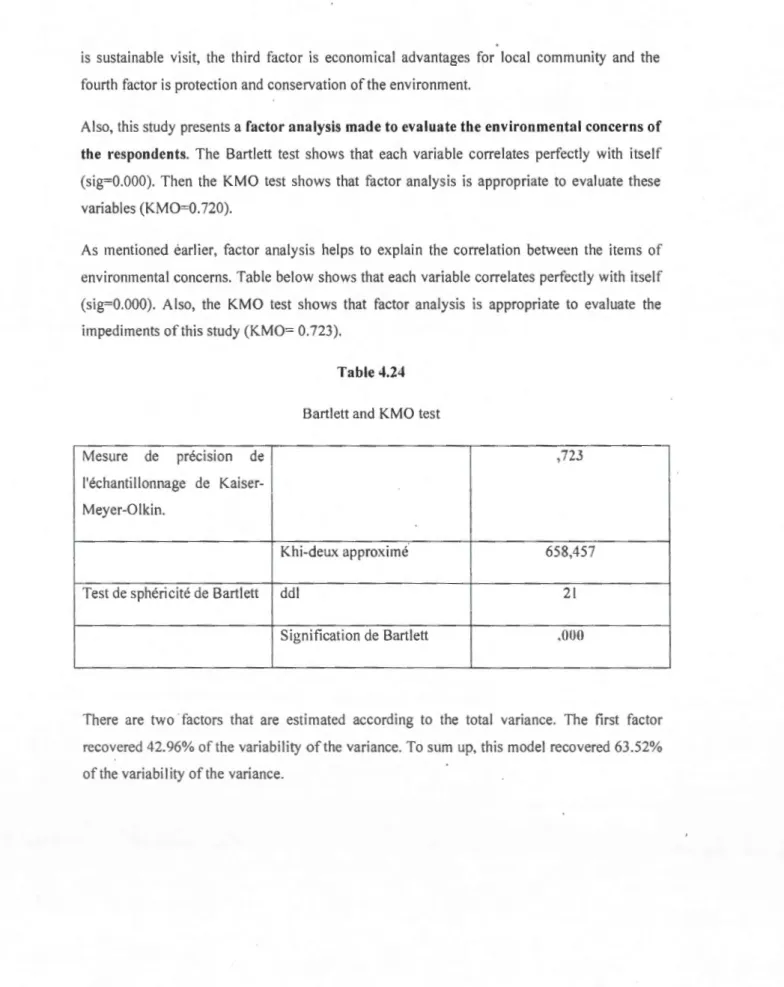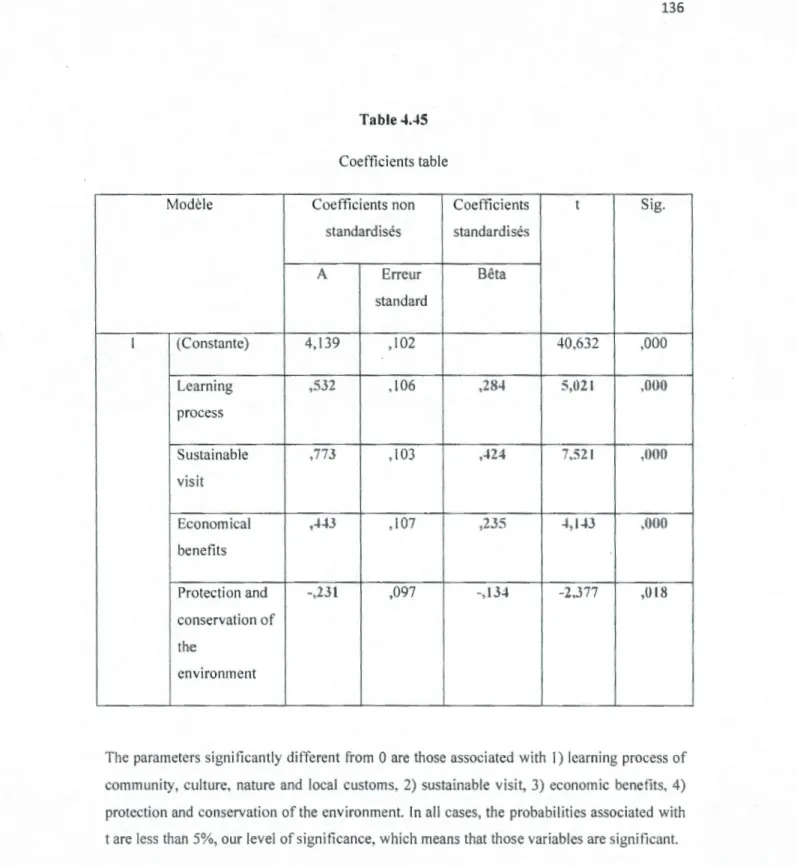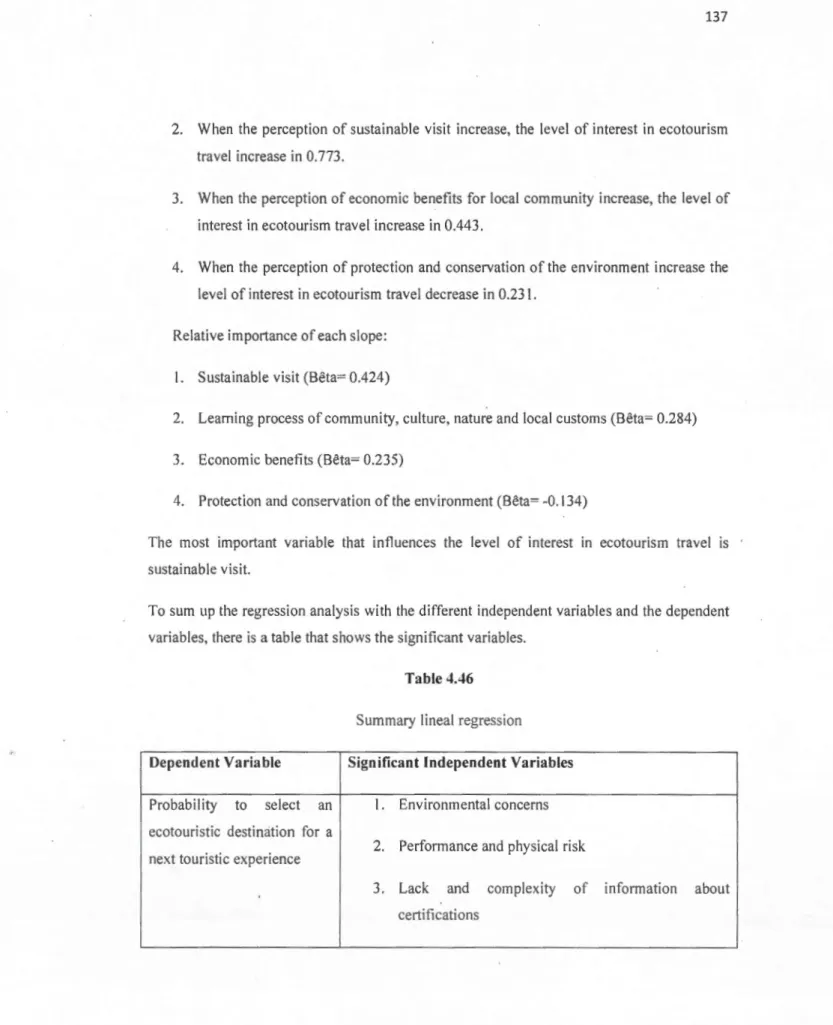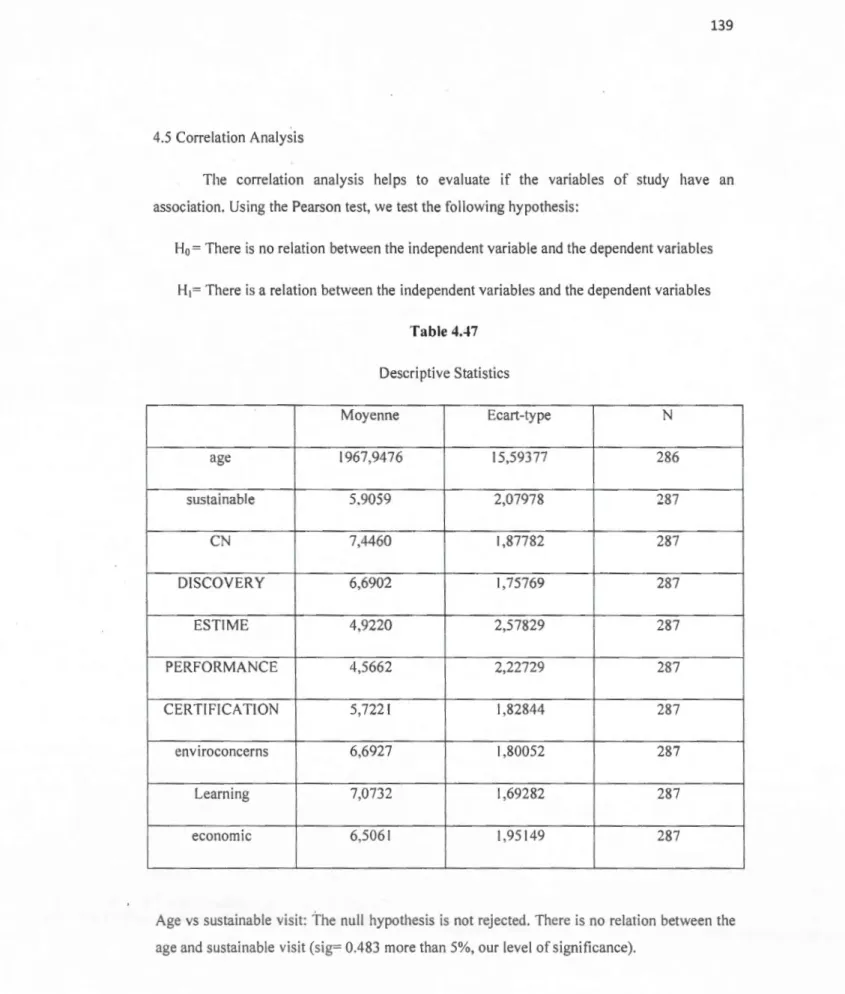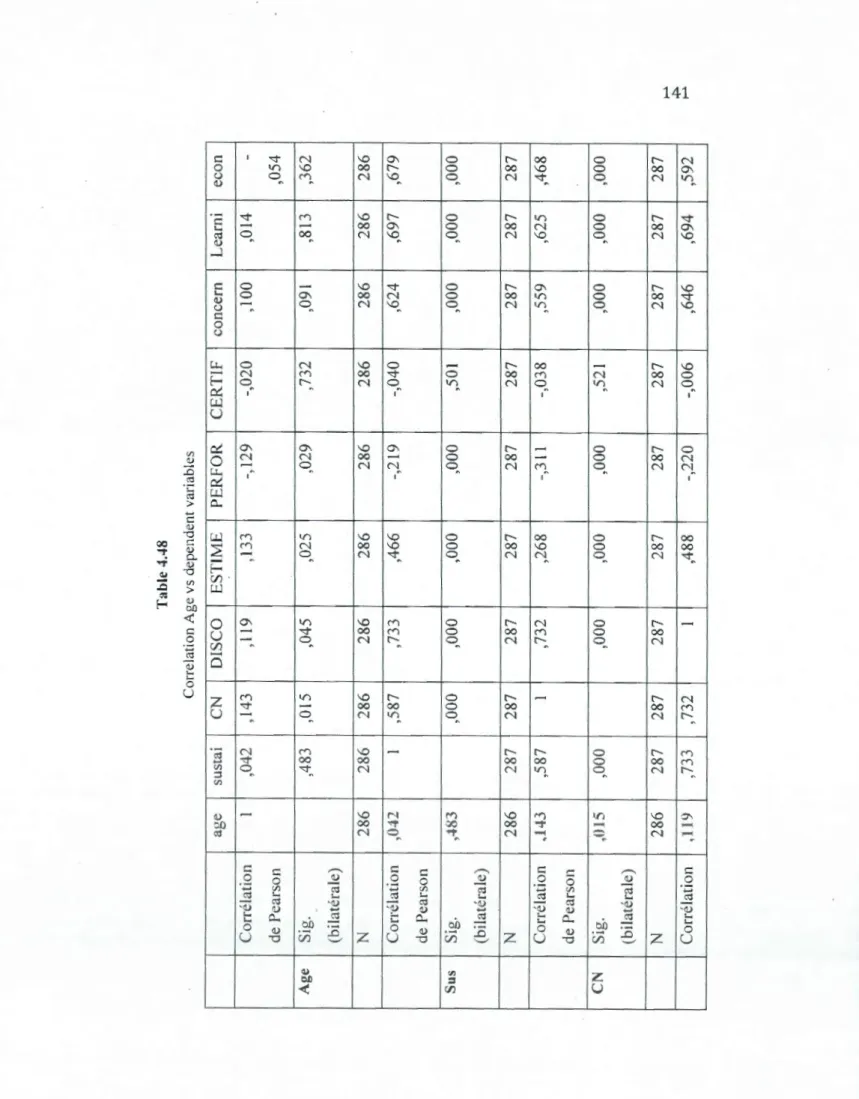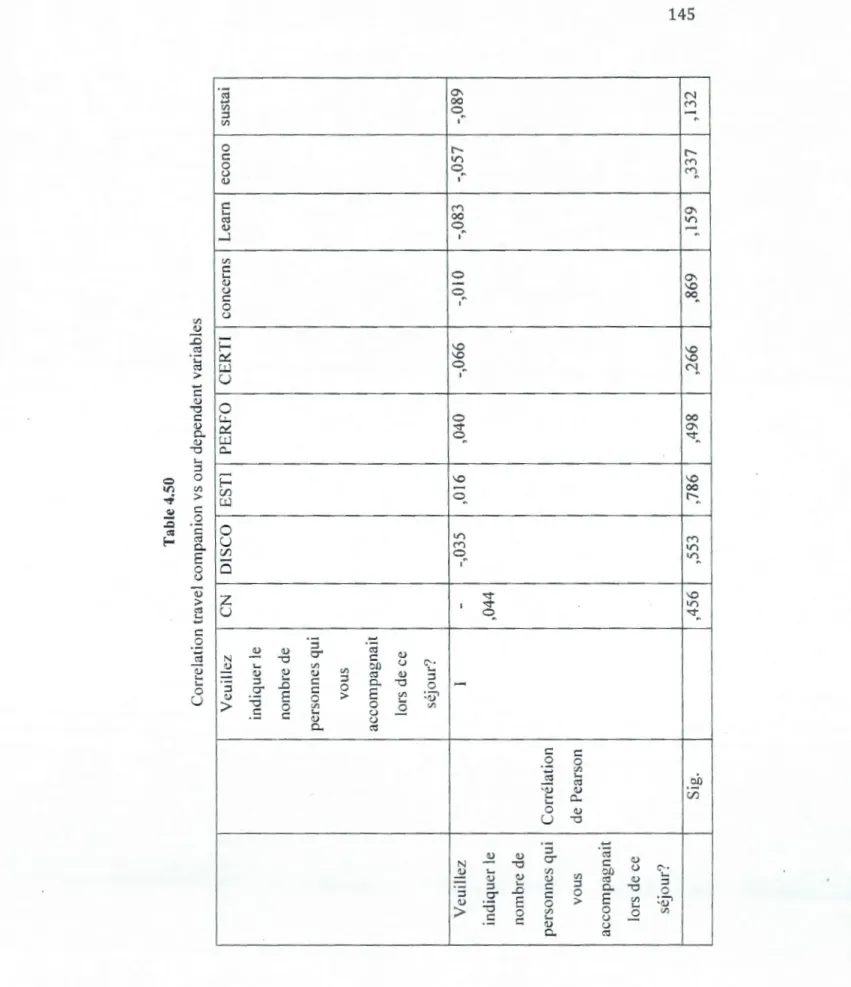ECOTOURISTS: PROFILE AND IMPLICATIONS FOR THE MARKETING STRATEGY
THESIS
PRESENTED
AS PARTIAL REQUIREMENT
OF THE MARTERS OF MANAGEMENT SCIENCES
BY
MARIA ALEJANDRA MARTINEZ CARVAJAL
A vertfssecrient
La diffusion de ce mémoire se fait dans le1 respect des droits de son auteur, qui a signé le formulaire
Autorisation
derapioduire
.
at
de diffuser un travail derecherche
de cycles sup~rlaurs (SDU-522- Rév.01-2006). Cette autorlsatlon.stlpule qua <4conformémentà
l'article 11 du Règlement no 8 dea études da cycles supérieurs, [l'auteur] concèdeà
l'Université du Québecà
Montréal une llc~nca non exclusive d'utilisation et da .publication oa la totalité ou d'une partie importante de [son] travail de rechercha pour des fins pédagogiques et non commèrclales. Plus précisément, [l'auteur) autorisa l'Université du Québec à Montréal
à reproduira, diffuser, prêter, distribuer ou vendre des
.· copies de. [son) travail de rechercheà
des fins non commerciales sur quelque support que ce soit, y compris l'Internet Cette licence et cette autorisation n'entrainent pas une renonciation de [la] part [de l'auteur]à
[ses] droits moraux ni à [ses] droits de propriété intellectuelle. Sauf ententé contraire, [l'auteur] conserva la liberté de diffuser et de commercialiser ou non ca travail dont [il] possède un exemplaire .. »ÉCOTOURISTES: PROFIL ET IMPLICATIONS POUR LA STRATÉGIE MARKETING
MÉMOIRE
PRÉSENTÉ
COMME EXIGENCE PARTIELLE
DE LA MAÎTRISE ÈS SCIENCES DE LA GESTION
PAR
MARIA ALEJANDRA MARTINEZ CARVAJAL
(UQÀM) for accepting to provide guidance for the completion of this thesis. He took the time to review ali the steps of this study from its development until its realization.
1 would also like to thank the evaluators of this thesis Prof. Dr. Raoul Graf and Prof. Marc-Antoine Vachon.
My gratitude goes also to GaiaPresse and the Observatoire de la Consommation that allowed the publication of the questionnaire link for the data collection.
Finally, 1 would like to thank my family for their support during my master's degree studies. Thanks to my uncle for his support and encouraging words, especially during the most difticult moments.
TABLE OF CONTENTS
LIST OF FIGURES ... v
LIST OF TABLES ... vi
LIST OF ABREVIATIONS ... ix
RÉSUMÉ ... x
ABSTRACT ... xii INTRODUCTION ... 1
CHAPTERI ENYIRONMENTAL CONTEXT. ... 5
1.1 History and evolution of ecotourism ... 5
1.2 Ecotourism in Canada ... 6
1.2.1 Ecotourism offer in Que bec ... 1 1 1.2.2 Ecotourism demand in Que bec ... 14
1 .3 Ecotourism certifications ... 15
1.3.1 Leed Certification ... 16
1.3.2 ISO 14001 ... 16
1.3.3 The Eco certification logo (Australia) ... 16
1.3.4 Pavillon Bleu ... 17
1.3.5 lei on recycle ... 18
1.3.6 Clé Verte ...... 18
1.3.7 Reservert ... 19
1.4 Importance of marketing in ecotourism ... 20
CHAPTER II LITERA TURE REVIEW ... 23
2.2 Ecotourism: Principles and characteristics ... 28
2.3 lndicators for monitoring the impact of ecotourism on the environment. ... 32
2.4 Advantages and disadvantages of ecotourism ... 34
2.5 Ecotourists ... 35
2.5.1 Segmentation: type of ecotourists ... 35
2.6 Motivations and impediments of tourists to purchase touristic packages ... 52
CHAPTERIII FRAMEWORK AND METHODOLOGICAL PROCESS ... 73
3.1 Framework ... 73
3. 1.1 Analytical framework ... 73
3. 1.2 Research questions and hypotheses ... 75
3.2 Research design ... 76
3.2.1 Research Type ... 76
3.2.2 Information needed ... 76
3.2.3 The measures and scales ... 77
3.2.4 The development of the questionnaire ... 80
3.2.5 Data collection ... 80 3.2.6 Pre-test questionnaire ... 80 3.2.7 Sampling ... 81 3.2.8 Data collection ... 81 CHAPTERIV RESULTS ANALYSIS ... 82 4.1 Profile of respondents ... 82
4.2 Reliability of the study ... 88
4.2.1 Reliability of impediments and motivations ... 88
4.2.2 Reliability of the items that measured ecotouristic behavior ... 89
4.2.3 Reliability of items that measured environmental concems ... 90
4.3 Factor analysis ... 93
4.3.2 Factor analysis for motivations ... 100 4.3.3 Factor anal y sis for ecotouristic behavior ... 1 07 4.4 Lineal regression ... ll4
4.4.1 Linear regression for the dependent variables probability to select an ecotouristic trip for the next touristic experience ... 114
4.4.1.1 Linear regression environmental concerns ... 117 4.4.1.2 Linear regression impediments and motivations ... 120 4.4.1.3 Linear regression ecotourism concerns ... 124 4.4.2 Li near regression for the dependent variable leve! of interest in ecotourism
travet. ... 127 4.4.2. 1 L inear regression environmental concerns ... 127 4.4.2.2 Linear regression motivations and impediments ... 130 4.4.2.3 Linear regression ecotourism concerns ... 134 4.5 Correlation analysis ... 139 4.6 A NOVA analysis ... 149 4. 7 Hypothesis results ... 191
CHAPTER V
CONCLUSIONS, LIMITS AND MANAGERIAL IMPLICATIONS ... 194 5.1 Conclusions ... 194 5.2 Limits ... 198 5.3 Managerial implications ... 199
ANNEX 1
QUESTIONNAIRE ... 202 ANNEX 2
DESCRIPTIVE STATISTICS ... 222
LIST OF FIGURES
Figure Page
0.1 Tourism industry employment 201 0 ... 1
1.2 Information sources for tourists ... 8
1.3 Tourists' reasons for visiting natural parks ... 8
1.4 Eco label Ecotourism Australia ... 17
1.5 Eco label Pavillon Bleu ... 17 1.6 Eco label Ici on recycle ... 18
1.7 Eco label Cie ve11e ... 19
1.8 Eco label Reservert. ... 19
1.9 La classitication des Marinas ... 20
TABLE LIST
Table Page
0.1 Proportion of expenditures in ecotourism and ad venture activities ... 3
1.2 Green ho tels in Que bec ... 12 2.3 Definitions of ecotourism ... 23
2.4 Principles of Ecotourism ... 32
2.5 lndicators for monitoring ecotourism impact in the environment. ... .33
2.6 Ecotourists profile ... 38
2.7 Motivations and impediments to purchase sustainable trips ... 54
2.8 Motivations and impediments to a responsible consumption ... 58
2.9 Motivations and impediments in ecotourism ... 61
2.1 OMost popular motivations and impediments ... 71
4.11 Socio-demographic protile: sex, age, status ... 82
4.12 Reliability statistics ... 88
4.13 Reliability for ecotouristic behavior. ... 89
4.14 Summary statistics for reliability of environmental concerns ... 90
4.15 KMO and Bartlett test ... 94
4.16 Total variance explained ... 94
4.17 Rotated factor matrix ... 96
4.18 KMO and Bartlett test ... 1 00 4.19 Total variance explained ... 1 01 4.20 Rotated factor matrix ... 1 03 4.21 KMO and Bartlett test.. ... 1 07 4.22 Total variance explained ... 1 08 4.23 Rotated factor matrix ... 1 09 4.24 KMO and Bartlett test. ... 113
4.25 Total variance explained ... 114
4.26 Rotated components matrix ... 115 4.27 S ummary factor analysis ... 1 16
4.28 Mode! summary ... 117 4.29ANOVA ... Il8 4.30 Coefficients table ... 119 4.3 1 Mode! summary ... 120 4.32 ANOVA ... 121 4.33 Coefficients table ... 121 4.34 Mode! summary ... 124 4.35 ANOV A ... 125 4.36 Coefficients table ... 126 4.37 Mode! summary ... 128 4.38ANOVA ... l28 4.39 Coefficients table ... 129 4.40 Mode! summary ... 130 4.41 ANOVA ... l31 4.42 Coefficients table ... 132 4.43 Mode! summary ... 134 4.44 ANOVA ... 135 4.45 Coefficients table ... 136 4.46 Summary linear regression ... 137 4.4 7 Descriptive statistics ... 139 4.48 Correlation age vs dependent variables ... 141 4.49 Summary age correlations ... 144 4.50 Correlation travet companion vs dependent variables ... 145 4.51 Mean: sex vs dependent variables ... 152 . 4.52 Sex vs dependent variables ANOV A ... 153 4.53 Mean: revenue vs dependent variables ... 156 4.54 Revenue vs dependent variables ANOVA ... 161 4.55 Mean: status vs dependent variables ... 164 4.56 Status vs dependent variables ANOVA ... 166 4.57 Mean: levet of education vs dependent variables ... 171 4.58 Leve! of education vs dependent variables ANOV A ... 173
4.59 Mean: destination vs dependent variables ... 170 4.60 Destination vs dependent variables ANOV A ... 178 4.61 Mean: trip duration vs dependent variables ... 174 4.62 Trip duration vs dependent variables ANOV A ... 181 4.63 Mean: season vs dependent variables ... 185 4.64 Season vs dependent variables A NOV A ... 187
UQAM TIES OCR CAGBC LEED ISO UNEP WTO SIDS ANOVA SPSS KMO
LIST OF ABBREVIA TI ONS
Université du Québec a Montréal
The international tourism society
Observatoire de la consommation responsable
Canada green building consul
Leadership in energy and environmental design
1 nternational organization for standardization
The nations environment programme
World trade organizations
Sustainable development of ecotourism in small islands developing states
Analysis of variance
Software product and service solutions
RÉSUMÉ
Le présent mémoire nous présente le profil des citoyens écotouristes et détermine les facteurs clés de succès d'une stratégie marketing centrée sur l'écotourisme.
L'analyse de la littérature fait ressortir six principes internationaux de 1 'écotourisme. Le premier principe est la protection et la conservation de l'environnement, qui inclue l'eau, les aliments, la nature, la flore et la faune. Le deuxième principe est le processus d'apprentissage de la culture de la communauté locale, de sa nature et ses coutumes, ce qui comprend également la sensibilisation environnementale. Le troisième principe est la visite durable par les touristes et la communauté locale. Le quatrième principe est l'avantage économique pour la communauté locale. Le cinquième est la minimisation de l'impact des visites touristiques sur 1 'environnement, et finalement la protection des droits de 1 'homme. Le cadre conceptuel présenté identifie les variables qui caractérisent l'identification des profils des écotouristes et le comportement écotouristique au Québec. En outre, ce cadre conceptuel présente les variables modératrices, il s'agit des facteurs socio-psychologiques, tels que les motivations et les freins; des facteurs sociodémographiques comme le sexe et l'àge; des facteurs situationnels et des préoccupations environnementales, qui modèrent positivement ou négativement l'impact du niveau de préoccupations écotouristiques sur le niveau d'intérêt pour les voyages écotouristiques et le degré de cette préoccupation dans le comportement écotouristique (aller à une destination écotouristique).
Les hypothèses de cette recherche sont :
H l.a: Le niveau de la préoccupation écotouristique a une impact sur le niveau d'intérêt pour une voyage écotouristique;
H l.b: Le niveau de la préoccupation écotouristique a une impact sur le comportement écotouristique (participation à un voyage écotouristique);
H2.a: Les variables socio-psychologiques (motivations et freins) modèrent positivement ou négativement l'impact du niveau des préoccupations écotouristiques sur le niv"eau d'intérêt pour une voyage écotouristique;
H2.b: Les variables socio-psychologiques (motivations et freins) modèrent positivement ou négativement 1' impact du niveau des préoccupations écotouristiques sur le comportement écotouristique (participation à un voyage écotouristique);
H3.a: Les variables sociodémographiques modèrent positivement ou négativement l'impact du niveau des préoccupations écotouristiques sur le niveau d'intérêt pour un voyage écotouristique;
H3.b: Les variables sociodémographiques modèrent positivement ou négativement l'impact du niveau des préoccupations écotouristiques sur le comportement écotouristique (participation à un voyage écotouristique);
H4.a: Les facteurs situationnels du voyage modèrent positivement ou négativement l'impact du niveau des préoccupations écotouristique sur le niveau d'intérêt pour un voyage écotouristiq ue
H4.b: Les facteurs situationnels du voyage modèrent positivement ou négativement l'impact du niveau des préoccupations écotouristiques sur le comportement écotouristique (participation à un voyage écotouristique)
H5.a: Le niveau des préoccupations environnementales modèrent positivement ou négativement l'impact du niveau des préoccupations écotouristiques sur le niveau d'intérêt pour une voyage écotouristique
H5.b: Le niveau des préoccupations environnementales modèrent positivement ou négativement l'impact du niveau des préoccupation écotouristiques sur le comportement écotouristique (participation à un voyage écotouristique)
Pour réaliser cette étude, nous avons administré un questionnaire en ligne sur la page Face book de 1 'Observatoire de la consommation responsable (ht!D.:L{w\y_w. f}l_ceb_ook.comiOCRe~ponsable ), sur le site Web du partenaire de l'étude GaïaPresse 01\tp)/.g;]j~IPI:~,?~_c;,ç_~!D. et via sa newsletter. L'échantillon de cette étude est de 287 participants.
D'après les résultats de cette étude, nous pouvons déduire que trois principes doivent être utilisés par les entreprises pour supporter les activités écotouristiques. Il s'agit principalement du processus d'apprentissage, la visite durable et l'avantage économique pour la communauté locale. En outre, les résultats de cette recherche permettent la validation des hypothèses H 1 a, H 1 b, H2a, H2b, H5a, and H5b. Par contre, les hypothèses H3a et H3b ont été partiellement confirmées. Cela signifie que les facteurs sociodémographiques, comme le sexe, l'âge et le niveau d'éducation, intluencent le niveau d'intérêt pour les voyages écotouristiques et le comportement écotouristique (aller à une destination écotouristique). En plus, les hypothèses H4a et H4b ont aussi été partiellement confirmées. Cela signifie que les facteurs situationnels, tels que le compagnon du voyage et sa durée, n'ont pas un effet modérateur sur la relation entre les préoccupations écotouristiques et nos deux variables dépendantes principales : le niveau d'intérêt pour le voyage écotouristique et le comportement écotouristique.
Grâce à cette étude, nous pouvons conclure que les écotouristes ont un niveau d'éducation supérieur, puisque le niveau d'éducation augmente le niveau des préoccupations environnementales. Les écotouristes aiment avoir le contact avec la nature. 1 ls estiment que l'écotourisme est une source pour découvrir de nouveaux amis et explorer la nature. Finalement, les écotouristes sont probablement motivés à choisir une destination écotouristique pour une expérience touristique, dans le cas où le voyage inclut la rencontre des gens qui ont le même intérêt.
ABSTRACT
The objective of this study is to identify ecotourists' profiles and to determine the key success factors in ecotourism marketing strategies.
The 1 iterature shows the proposai of international principles of ecotourists. They are six. First is protection and conversation of environment, which includes water, aliments, nature, flora and fauna. Second is the learning process of the local community culture, nature, and customs, which also includes environmental awareness. Third is Sustainable visit for both tourists and local community. Fourth is an economie benefit for the local community. Fifth is minimization of the environment impact of the tourists' visits and sixth is the Protection of human rights. This framework that will be presented tries to identify the variables that mode! the identification of ecotourists' profiles and ecotouristic behavior in Quebec. ln addition, this framework shows moderator variables, which are socio-psychological factors like motivations and impediments, socio-demographical factors like sex and gender, situational factors and environmental concerns that moderate positively or negatively the impact of the leve! of ecotouristic concern in the leve! of interest in ecotourism travel and the leve! of ecotouristic concern in ecotouristic behavior (going to ecotouristic destination).
The hypothesis of this research are :
H l.a: Ecotouristic concerns influences the leve! of interest for ecotouristic travel
H l.b: Ecotouristic concerns influences the ecotouristic behavior (going to ecotouristic destination)
H2.a: Socio-psychological variables (motivations and impediments) moderate positively or negatively the impact of ecotouristic concerns on the leve! of interest in ecotourism travel H2.b: Socio-psychological variables (motivations and impediments) moderate positively or negatively the impact of ecotouristic concerns on ecotouristic behavior (going to ecotouristic destination)
H3.a: Socio-demographic variables moderate positively or negatively the impact of ecotouristic concerns on the leve! of interest in ecotourism travel
H3.b: Socio-demographic variables moderate positively or negatively the impact of ecotouristic concerns on the ecotouristic behavior (going to ecotouristic destination)
H4.a: Situational factors ,moderate positively or negatively the impact of ecotouristic concerns on the leve! of interest in ecotourism travet
H4.b: Situational factors moderate positively or negatively the impact of ecotouristic concerns on ecotouristic behavior (going to ecotouristic destination)
HS.a: Environmental concerns moderate positively or negatively the impact of ecotouristic concerns on the leve! of interest in ecotourism travet
H5.b: Environmental concerns moderate positively or negatively the impact of the leve! of ecotouristic concerns on ecotourisics behavior (going to ecotouristic destination)
To make this study an online questionnaire was published in the Face book of l'Observatoire de la consommation responsable (http://www.facebook.com/OCResponsable) and in the website of the partner ·of this study, GaïaPresse (http://gaiapresse.ca/), via the ir newsletter. The sample of this study is 287 participants. The results of the survey will act as a classic
academie dissemination in the form of articles in journals or conferences. Also, a special issue of knowledge transfer will be published in GaïaPresse.
The results of this study show that there are three principles that should be used by enterprises to support their ecotourists activities. Those principles are learning process, sustainable visit and the economie benetït for local community. Also, the results of this research let the validation of the hypothesis Hia, Hlb, H2a, H2b, H5a, and H5b. The hypothesis H3a, H3a were partially contïrmed, which means that some socio-demographical factors such as sex, age, and leve! of education influence the leve! of interest in ecotourism travel and ecotouristic behavior (going to ecotouristic destination). In addition, the hypothesis H4a, and H4b were partially contïrmed, which means that situational factors such as travel companion and trip duration do not have a moderator effect in the relation between ecotourism concerns and our two major dependent variables in this study, leve! of interest in ecotourism travel and ecotouristic behavior (going to ecotouristic destination).
This study concludes that, in general ecotourists have a high leve! of education; as educational leve! increases the leve! of environmental concerns also increases. They like to have a close contact with nature. They fee! that ecotourism is a source to discover friends and nature. Finally, ecotourists are likely motivated to select ecotourism destination for their touristic experiences if the package or trip includes meeting new people with the same interest.
INTRODUCTION
Tourism has become one of the most important factors of revenues in the economy of many countries. ln Canada, for example, figure tourism is a source of employment for many Canadians; tigure 0.1 shows the distribution of jobs that were created by tourism in 201 O. The accommodation and food 1 drinks are areas that capture the largest share of tourism employment. Also, this graph shows different elements that determine the employment by the tourism industry. Transportation occupies 12%. Accommodation occupies 25%. Food and Beverage Services occupy 25%. Recreation and Entertainment occupy 12%. Travel Services occupy 7% and others industries occupy 19%. ln 2010, tourism activity represented 2% of Canada's Gross Domestic Product (GDP). A Iso in 200~, Canada had the fïfteenth place in the United Nations World Tourism Organization Ranking of International Tourism Receipts with a compound annual growth rate of 4.28% (lndustry Canada, 2009). Actually, there are different kinds of tourism.
12"k 25% 25% Figure O.l o Transportation o Accomnodation 111 Food and Bev erage Services o Recreation and 61tertainment 12 Travel Services • Other Industries
Tourism Industries Employment, 2010
Retrieved from Tourism Industries Employment (20 12), lndustry Canada, 2010
ln Quebec, the tourism industry is one of the most important sources of revenues. The tourism industry occupies the eighth place in the ranking of major exportation products. ln
addition, the Minister of Tourism of Quebec showed that Quebec welcomed 62.708 thousands of visitors in 2008, which generated an average expenditures of $9,459 million Canadian Dollars (Ministère du Tourisme, 201 0). For example, Que bec offers 108,699 camping spots. These places have witnessed an occupation rate of 52% by seasonal visitors and another rate of28.8% by temporary campers/visitors (Ministère du Tourisme, 2010).
Over the past decades, with the increased popularity of environmental concerns and biodiversity, a new form of tourism has been developed worldwide, ecotourism. Ecotourism is complex a term to define. because currently there is no unique definition that has been accepted by the academia. James Higham (2007) has many definitions of écotourism. He identifies ecotourism as "a sustainable manner of tourism that has a positive impact on the environment". For example, tlora, fauna, particular landscapes and ecosystems are common elements of ecotourism. These elements are meant to be protected. One of the definitions that is used frequently states the following: ''Ecotourism is a responsible travel to natural areas and that conserves the environment and improves the well-being of local people" (TIES, 1990).
According to the Réseau de Veille en Tourisme (2008), ecotourism and tourism industry in Que bec generales Il ,400 jobs. every year. Further, 1' Adventure Écotourisme Que bec (2004), said that "one r~f every two Quebecers (57.1%) indicated having participated ta eco/ouristic activities or adventure tourism in the fast year" (L' Adventure Écotourisme Que bec, 2004 ). Also. they presented the following table, which displays the proportions of expenditures allocated to ecotouristic and adventure activities, by types of touristic expenditures.
Table 0.1
Proportion of expenditures in ecotourism and adventure activities
Les dépenses récréotouristiques selon le type de dépenses
Transport 821 238 472$ 27 o/o Hébergement 254 424 446$ 8% Nourriture 585 395 681 $ 19% Équipement 1 133 175 416? 38% Services 220 874 251 $ 7% Total 3 015 108 266 $ 100%
Dépenses récréatives et touristiques selon le lieu de dépenses
Récréatives 2231172519$ 74%
Touristiques au Québec 657 878 527$ 22%
Total des dépenses
l 889 051 046 $ 96%
faites au Québec
Touristiques hors Québec 134 459 130$ 4%
Adapted from n.d. (2004), L 'Adventure Écotourisme Quebec: Étude sur la valeur économique de 1 'écotourisme et du lotirisme d'aventure.
lt is relevant to point out that the activities from ecotourism and adventure generated an amount of $2.9 million of Canadian dollars of expenditures, in 2004. Outside of Quebec, these types of activities generated an amount of $135 million of Canadian Dollars of expenditures, outside of the province of Que bec (in the rest of Canada) (L'Ad venture Écotourisme Quebec, 2004). This is information of utmost impor1ance for motivating enterprises to invest in this ki nd of tourism.
The literature about ecotourists is relatively poor. ln particular, we do not know many things about ecotourist consumption behavior and their specifie protïles. There are sorne studies that
try to identi fy the preferences and 1 ikes of ecotourists ( e.g. Weaver, 20 1 0; Prim-AIIaz et al., 2009; Zofragos et al., 2007; Chang-Hung Tao et al., 2004; Weaver et al., 2002; Galloway, 2002; Twynnam et al., 1997; Palacio et al., 1997; Lindberg, 1991 ), but they are not contextual, they need to be updated. They also need to have a representative sample, which implies random sam pies that are representative of the population.
Further, in Quebec there are not many organisations that follow ecotourist guidelines. ln this region the projects from Reseau de Veille en tourisme del 'UQAM and the Observatiore de la Consommation Responsable are the only ones available that show statistics about ecotourists' preferences and behaviors in Quebec (ex: Guide de l'écotourisme au Quebec). Who are the ecotourists in Quebec? Are Quebecers ready to implement ecotourism practices? ln Quebec, which means are used in arder to promote the development of ecotouristic practices?
The objective of this study is to identify ecotourists' profiles and to determine the key success factors in ecotourism marketing strategies. To achieve this objective a survey was conducted. The sample used for this survey was composed of 287 Quebecers. This thesis is encompasses 5 chapters. The tirst chapter discusses the environmental context of ecotourism in Quebec. The second chapter presents the literature review on ecotourism. The third chapter contains the framework and the methodology design. The fourth chapter presents the results and the ti fth chapter presents the discussions and conclusions of this study.
---CHAPTER l
l. ENVIRONMENTAL CONTEXT
l.l History and Evolution of Ecotourism
Tourism has been one of the most important factors for the economy of many countries. Through history tourism helped many countries to develop severa! key industries in order to improve their economies. However, in !970, severa! researchers realized that tourism also had a negative impact on the environment. Hector Ceballos-Lascurain (a Mexican architect and environmentalist) created the term ecotourism, which is a mix from the terms: eco/ogy and tourism, namely an ecologically-responsible tourism. Ceballos believed that the environment could have benetits from tourism rather than suffer from its negative consequences. Ceballos started to explain the idea of ecotourism to people from
severa! regions in Mexico. This idea became one of the most popular touristic options to
protect the environment and to visit different places while preserving nature (Fennell, 2008).
The first concept that people recognized of ecotourism dates back to the l970s, although it was only formally defined in 1990 by the International Ecotourism Society, which described ecotourism as "Responsible travet to natural are as th at conserves the environment and
improves the well-being of local people.··
Despite this and other efforts to forma! ize the concept, ecotourism has al ways been the victim of term inological ambiguity" (Ho ney, 2008).
ln 1980, ecotourism increased its popularity thanks to many companies that saw in this strategy an efficient way to obtain more profits. Enterprises noticed .that people were really interested in traveling. They started to make lots of researches in order to eva! ua te the profitabi lity of tourism. Studies showed that, in general, people wanted to explore nature and to relax. Consequently enterprises started to invest in natural places to attract potential tourists. Accommodations were designed as simplistic and natural. ln this way ecotourism began (Arnegger et al., 201 0).
In 1990, communities and natives started to real ize th at they could also the benefits from this ki nd of tourism. They learned about the environment surrounding them and were thus able to teaeh tourists about flora, fauna and cultural customs. ln the Iate l990s, those communities asked for help from big companies and organizations. They wanted to learn about tourism management and to create programmes intended for ecotourists when they wanted to visit those places (Ecotourism Web Blog, 2008). "At the same lime, firms seeking ta remain competitive and ta survive in the market began to incorporate these new/y emerging concerns
in the ir management and marketing decision making [. . .} demand for green products were
driving forces behind the resurgence o.l green marketing, the aim of which is to achieve a
balance between the objectives ol sales and profits, on the one hand, and a concern for
society and the environment, on the other" (Paco et al., 2009).
At the moment ecotourism is still a growing industry that is willing to please tourists and new investors to natural places. Ecotourism does not have much history but researchers say that it is a developing sector, which has a lot of ways to save the environment that people visit. Researchers said that as people protect natural resources now, people will reap the benefits from such practices in the future. The sustainable development must become a reality for the good of ali (Epier, 2002)
The evolution of ecotourism is still a subject to explore and to recognize. Ecotourism started as a solution for a problem. Now, it has become an important sector for the economy of many countries. Also it has become a rescue for the places where humans had been destructive. lt is necessary th at people take control of wh at they consume or even touch because if people do not protect natural resources, the future of mankind will be in danger (Fennell, 2008).
1.2 Ecotourism in Canada
Many organizations 111 Que bec try to promote different types of tou ri sm th at encourage protecting and caring for nature. For example, The Committee on the Environment and Sustainable Development made a recommendation to the Governement of Que bec, which stipulates the following: '·We demand that our government promotes ecotourism combined with conservation, environmental education and the economical development of local communities" (The Committee on the Environment and Sustainable Development, 2002). ln
response to severa! recommendations and the business opportunities that ecotourism could
have for the region, 'n 2009, the Ministère du Tourisme developed a brand strategy to
enhance the tourism industry. The objective of this market positioning was to encourage innovation and performance in the tourism sector and also to promote. at the international
leve!, the quality of the tourism products offered in Québec. The strategy targets five tourism
activities with high growth potential: Nature Tourism, Aboriginal Tourism, Outfitting,
hunting and sport fishing, Cultural Tourism, Farm tourism (Que bec Government, 20 Il).
To understand the strategy of the Government of Quebec in relation with natural tourism, it is
necessary to make a definition according to this organization as follows: Ecotourism is "--->.
ln tact, the provincial and federal governments have created sorne 27 national parks in an
effort to preserve the region's most representative specimens and to offer the public the pleasure of exploring these vast expanses of wilderness" (Official tourist site of the
Government of Québec, 201 1 ).
This paper emphasizes nature, experience and responsible consumption, as important variables to evaluate since increasingly more people talk about ecotourism and new ways to develop the region. "Afew ecotourism opera/ors have started their work, one involving whale watching on the pacifie coast. But in most national parks and others protected areas, including Wells Gray Provincial Park; ecotourism isjust a theoretical lerm" (Gornet, 2005).
According to a study made in 1997 about tourist perception in British Columbia. "on/y 53% (?[the population used provincial parks in 2001. Most Canadiansfound out about Wells Gray Park from ji-iends and relatives (See fig. 1.2). Many Canadian visitors to Wells Gray Park live nearby. Although other information sources like !ravel books, !ravel agencies and the information centre at Clearwater are used, some tourists .fi nd out about the park .from other media s uch as newspapers, but this potentially strong source of information through articles, new stories, and advertisements. is not widely usee!" (Gornet, 2005).
30 20 10 0
[
... . ... . -. -. ' r-l ' r-·:1. '[
0
Numberofl
Canadlan tourlsts "' ~ "' c: -o...
'ô .~ c: -5 ~ -~ 0...
E ;;; E ë u..2
..
u-=
Figure 1.2Information sources for tourists Retrieved from Gornet, (2005)
Also, this study shows how important it is that governments, enterprises and society know how to attract tourists to national parks and protected areas that give the opportunity for consumers to experience an ecotourism trip. The figure 1.3 displays tourists' main reasons for visiting natural parks (Gornet, 2005):
16 1. 12 10 8 6 4 2 0
t
.
... J 1 c: 2j
..
a:: 1!
---·
-r···
l _ _ _ Figure 1.3Tourists' reasons for visiting natural parks Retrieved from: Gornet, 2005
The desire to enter in contact with nature and the search for relaxation are the main reasons for tourists to visit natural parks a bit further cornes the motivation to study parks and finally the need for adventure. According to this study, travel and itinerary are not important for tourists when tourists choose a travel destination (Gornet, 2005).
Sometimes consumers or potential consumers are worried about "which hotel protects more actively the environment? Which offers better support of its local community? Such
questions may be more important to vacationers than the proximity of the hotel with the
beach or the type of mint letton the pillow" (The Futurist, 2005). Consumers are trying to be
more responsible with their consumption. This is the point, where enterprises have an
enormous task by trying to influence consumers in the purchase of an ecotourism travet. Enterprises have to make sure that consumers will be satisfied with the options that they chose for their trip; in that system, agencies will make consumers come back next time they want togo on vacation (Wang, 20 l 0).
Enterprises have the responsibility to attract consumers into ecotourism trip. Meanwhile, they
also need to intluence tourists' about their behaviors white they are enjoying a nice time in an
ecotourism place, because "ecological tourists are the market converters for value of ecotourism resources and are also protectors and destructors of ecotourism resources, so we have to conduct education on them in the aspect of correct ecological value discovery and ecological appreciation" (Wang, 201 0).
There are some strengths, weaknesses, opportunities and threats of ecotourism products that enterprises need to consider in the development of their business in the region of Quebec. Tourisme Québec (2002) made a document in which it describes strengths relate to the
natural heritage, culture, development of ecotourism products, commercialization, and
ecotourism enterprises in Quebec. At the same time, it describes weaknesses, opportunities and threats for all levels. Some of these strengths, weaknesses, opportunities and threats are
underlined below:
Strengths: ln relation with the natural heritage, Quebec extends over a large territory that is characterized by important hydrographie resources and severa! lakes. Also, Quebec has the St-Laurent River, which provides biodiversity in relation to faLma, flora, and diverse cultures to the region. ln addition, Quebec has wild landscapes and untouched places, where tourists can enjoy a close contact with nature. Further, in relation to culture, in Quebec, there are 54 communities and Il aboriginal nations, which give the tourists severa! possibilities to learr\ about different customs and habits. ln relation to the development of ecotourism products and commercialization, Quebec counts with severa! investors that provide the region with the
capital promote natural places and make tourists aware of impact on the environment. A Iso,
the government, local tou ri sm organizations and "A TR" help to promote ecotourism travel
(Tourisme Québec, 2002).
Weaknesses: in relation with natural heritage, Quebec has damages in certain natural places,
and severa! water courses are the polluted. ln relation to culture, Quebec has lost expertise in
such cultural activities as crafts and arts, because of lack of generational takeover. The
weakness in the development of ecotourism products andcommercialization, is the lack of
innovation in the development of products, there are not practical access for tourists to
natural places. ln relation to the enterprises in the sector, Quebec does not have entry barriers,
which makes difticult for small enterprises to have competitive advantages (Tourisme
Québec, 2002).
Opportunities: tirst of ali, ecotourism is a growing sector, which gives the possibility to many
enterprises to develop their services and products that can fultill consumers' expectations.
A Iso, the use of new technology and internet help to generate new methods of promotion and
awareness of the environment. At the same time, internet can be developed as a research
motor for the research, reservation, and information about ecotourism places and enterprises.
Quebec has the opportunity to create a position in the market as a nature destination
(Tourisme Québec, 2002).
Threats: global warming is one of the main problems for Quebec landscapes, the
deterioration of faLma, and flora put Quebec in a difticult position, where the government
needs to work and concentrate its efforts on raising awareness and educated ali tourists. The existences of some species like insects in summer session make difticult the travel for
tourists, which '·reduces the quality of the experience for the consumer" (tourists) (Tourisme
Québec, 2002).
According to the information presented by Tourisme du Québec (2002), enterprises have sorne knowledge about the way their work could be done, in the region. A key question here
is what are the influences that impact on consumers purchases? This paper will.go back to
this question in the following chapters.
----1.2.1 Ecotourism offer in Quebec
According to Tourisme Québec (2002), the Quebecer Ministry of Tourism has classified severa! activities that can be part of ecotourism. To strengthen the promotion of
these activities Tourisme Québec (2002) shows and describes the places where tourists can
have an ecotourism experience. For example, Quebec has a forest terri tory of more than one million of square kilometers as weil as three large rivers (St Laurent, Bahia Hudson and Bahia Ungava).
ln addition, the government bas created severa! protected areas between parks, and reserves
to increase the ecotourism offer and the control of the environment. These protected areas
re present 4.85% of Que bec' s who le terri tory (Tourisme Québec, 2002).
ln Quebec there are three major national parks. The tirst one is the Maurice park-s, which has
an area of 536 square kilometers. This park is located in Maurice. The second national park is
Forillon, which has an area of 244 square kilometers. This park is located in the Gaspésie
region. The third major national park is Mingan, which hasan area of !50 square kilometers.
This park is located in the Duplessis region. Ali these parks have unique ecotourism activities that tourists can enjoy (Tourisme Québec, 2002).
Quebec offers four touristic regions to be in contact with the marine environment. First is
Saguenay-Lac-Saint-Jean. The second is Charlevoix. The third is Manicouagan. The fourth is
Bas-Saint Laurent. Further, Quebec offers severa! parks for the local market. Sorne of these
parks are Îles-de-Boucherville, Mont Saint-Bruno, Yamaska, Mont-Megantic, Mont-Orford
and Frontenac (Tourisme Québec, 2002).
ln addition, Tourisme Québec (2002) presents sorne elements that characterize the providers
of ecotourism offers in the region. First, trip duration varies between one to five days.
Second, generally the transportation method is either by foot or by cruisers-. Third, is the importance that ecotourism providers give to the observation of birds ~nd mammals. These characteristics made the ecotourism Quebec a source of enjoyment and relaxation for the tourist (Tourisme Québec, 2002).
-Actually, in Que bec tourists can fi nd 1 ,040 enterprises dedicated to ecotourism, which
represents 3.15% of the 33,000 tourism enterprises in the region. Those enterprises are
composed of hosting, restoration, transport, travel agencies, congress, attractions, touristic
services and ad venture tourism, which gives the sector a strong base to compete with national
and international players (Tourisme Québec, 2002).
According to the web page of A venture Écotourisme Québec (20 12), these enterprises need
to be accredited with rigorous "safety standards, specialized guides, quality equipment,
liability insurance, thorough knowledge of the natural environment, a rewarding experience
(local guides will ensure that you get the most from the change of scenery)". As a result. ecotourists will have more trust in the ki nd of package that they want to purchase.
Hebert (2010) made a list of ten hotels in Quebec that ecotourists can visit and see the
protection and maximization of the local resources. The table shows the green activities that
these green hotels do in Quebec.
Table 1.2 Green Hotels in Quebec
Ho tel
Le Delta Sherbrooke
Hôtel Gouverneur Le Noranda,
Rouyn-Noranda
Green Activities
-Recycling, reutilization
of
100% of the irresidual matters.
-Reduction of printing.
-Use ofiPad to avoid the use C?fnewspapers.
-Promotion of Hybrid car use.
lt is the only hotel in the region thal has the
certification of the program for sustainable tourism of ['Association des Hôteliers du Québec.
Holiday Inn Express, Saint-Hyacinthe
Château Laurier, Québec
Intercontinental Hotel, Montreal
Godefroy Inn, Becancour
Hotel Le Francis, New Richmond
Hotel La Fabreville, Laval
Hotel Chicoutimi, Saguenay
-Persona! Hygienic products thal minimize the impact on the environment.
-Encouragement of bicycle use
-Working to obtain the LEED certification. -Reduction of energy and water consumption. -Promotion of Hybrid car use.
-Reduction of water cons umption. -Consumption c?flocal products.
-Use of ecological persona! hygienic products.
-Reduction of printing. -Purchase of local products.
-Reduction of water consumption, food and soap.
- Reduction of conswnption.
-Management (if energy consumption.
-Recycling.
-2% ol annual profits related to sustainable activities.
-Awareness: Clients purchase tree in ex~hange for the GES emissions !hat they create.
-the soap is produced near the hotel.
-Use of bio- products.
Chateau Cartier, Gatineau -Rooms renovation (green).
-Promotion of bicycles use.
He ber, Claudine 201 O. Les A ffaires.com
Also, Spa Eastman is a case that has been documented by academicians; this Spa offers
massotherapy, body care, esthetic services, and information services for ali their visitors. lt
follows the reduction, reutilization and recycling (3R). The protection of the forest, water
economy and sustainable transport are core elements for the Spa. Throughout the years, this
Spa has been using sustainable development as a base for the ir offering (Brieu et al.. 20 Il).
Brieu et al. (20 Il) said that the Spa Eastman is a clear example of the protïtable success that
could be the ecotourism as a business, provided that it is well-managed. Further, Brieu et al. (20 Il) sa id that ali the variables that they had studied to evalua te the leve! of sustainable tourism that Spa Eastman make day-by-day, respect for the environment was seemed the
most important of them. ln consequenèe, this variable has a significant intluence 111 the
selection of a touristic activity.
ln general, ecotourism enterprises may offer educational features to the visitors, to help them
to understand that every person could minimize their consumption in elements like water,
energy, and pollution. Enterprises should teach ecotourists about their impact on the environment. The awareness of tourists is a task that ecotourism enterprises need to consider
for the developing of the ir activities (Hayala, 1996).
1.2.2 Ecotourism demand in Quebec
According to Tourisme Québec (2002) in 2002 there was no documentation about the
experiences of ecotourism travel or profile of ecotourists in Quebec. However, Tourisme
Québec (2002) made an estimation
of
ecotourism demand in relation to the statistics thatshowed that. in 1999, there were 5 million of tourists who were participating in activities
related to nature, which is a big market, where ecotourism can have a good value.
According to the Guide de 1 'écotourisme au Québec (20 1 1 ), the total spending 111 the ecotourism sector and adventure tourism sector amounts $800 million Canadian Dollars,
which is equivalent to the 10% of total tourism spending in Que bec. In the case of services expenditures, Quebecers spend about $70 million Canadian Dollars, which means that this
industry has severa! opportunities for the growing businesses.
Fotiou et al. (2002) discussed that, in order to avoid problems in the demand for ecotourism,
places like parks and protected areas should create special tours for ecotourists, which can
include information session about the fauna, flora, plants and. nature in general to inform
tourists and create awareness. Enterprises should use their Public Relations activities, which
include media coverage of environmental activities and achievements for the promotion of
ecotourism travels. The communication of ecotourism activities could have relevant results for the industry.
1.3 Ecotourism certifications
According to a study made by Tourism Queensland in 1999, ecotourism
certifications and accreditations have a big impact in the selection of the ecotourism trips by
tourists (Tourisme Québec, 2002). This study showed that one out of every three tourists had
made their selection by taking into account the programs that had accreditations. Also, two
out of every three tourists knew the accreditation du ring the trip. 87% of these tourists agreed
to select the trip in relation to accreditation and certifications of tourism companies.
Tourisme Québec (2002) points out that there are two projects to create international
certifications for ecotourism. First, there is the Rain Forest Alliance certification, which is controlled by the Sustainable Tourism Stewardship Council, in Latin America. The second is the Nature and Ecotourism Accreditation Program control by Ecotourism Association of Australia and Green Globe 21. Next, this paper will show sorne certifications, and ecolabels that are used in Quebec.
1.3.1 Leed Certification
It is a program, which recognizes the leadership in the ecological construction. It was tirst introduced in 2000, in the United States, and since then, it bas become a relevant certification for the construction industry. "LEED® Certification distinguishes building projects that have demonstrated a commitment to sustainability by meeting the highest performance standards" (Cagbc, 20 12). The web site of the Cagbc teaches ali the procedures and requirements to obtain the certification (Cagbc, 20 12). The Cagbc tries to make aware, educate and train the constructors on the importance of the protection and conservation of the environment (Cagbc, 20 12).
1.3.2 ISO 14001:2004
According to the International Organization for Standardization, this norm will apply for enterprises that fulfill the requirements for an environmental management system. ISO 14001 :2004 will take into account legal requirements. "It applies to those environmental aspects that the organization identifies as those which it can control and those which it can influence. It does not itself state specitic environmental performance criteria" (International Organization for Standardization, 20 Il).
1.3.3 The Eco certitication logo (Australia)
This logo is recognized in ali around the world. Also, it allows ecotourists to recognize a real ecotouristic adventure, as environmentally friendly and sustainable. '·The ECO Certification program ensures travellers that certified products are backed by a strong, well-managed commitment to sustainable practices and provides high quality, nature-based tou ri sm experiences" (Ecotourism Australia, 20 Il). Ecotourism Australia (20 Il) said that this certi tication has been exported ali around the world as the International ECO Certification Program.
Figure 1.4
Ecolabel Ecotourism Australia Retrieved from: Ecotourism Austral ia, 20 1 1
Some of the certifications that tourists can ti nd in Quebec are: Pavillon Bleu, Ici on recycle, Clé vert, Reservert, La classification des Marinas, La cert(fication Eco-marina. 1 n the following li nes, this paper will explained each of these certifications.
1.3.4 Pavillon Bleu
lt is a label certitication. lts objective is ''to recognize the environmental performance of beaches and marinas. This certification program is exclusive for the environment" (Certitïcation Quebec, 20 12). To obtain this certitïcation, enterprises should be evaluated in
"water quality, environ mental learning, information, environmental management, health and
security" (Certification Que bec, 20 12).
Figure 1.5
Ecolabel Pavillon Bleu
1.3.5 lei on recycle
This program encourages the adoption of good practices for the reduction, reutilization and recycling of the valorization of residual matters (3RV). The Government of Quebec proposes three levels of engagement in the program; the first levet is called Engagement, the second levet is called Mise en oeuvre, and the third levet is called Petformance (Gouvernement du Que bec, 201 l ).
iCi
/Z
N
RECYCLE!
Figure 1.6
Ecolabel Ici on recycle
Retrieved from : Gouvernement du Que bec, 20 Il
1.3.6 Clé Verte (Hotellerie)
The most important objective of this program is to evaluate Quebecer hotels' plans to minimize their environmental impact. Some of the actions that this program evaluates are in relation to the consumption of energy and water, etc. According to the compromises that hotels make and the actions that they undertake to protect and to sustain the environment,
L'Association des hôtels du Canada will provide those hotels that seeks certification with a
score ranging from 1 to 5 Clé Verte, 1 being the lowest score and 5 the highest (Corporation
1.3.7 Reservert
CL
VERTE
Système d'estimation
écologiqu
e
Figure 1.7
Ecolabel Cie verte
Retrieved from: Corporation de l'industrie du Quebec, 2012
lt is a program that allows hotels in Quebec to be certitied by the Association des
Hoteliers du Que bec for the ir work in sustainable development. They wi Il ev al ua te hotels in
economie, environmental and social factors (Corporation de 1' industrie du Que bec, 20 12).
,
reser
c.
Figure 1.8
Ecolabel Reservert
Retrieved from: Corporation de l'industrie du Quebec, 2012
In the case of the certification of marinas in Quebec, tourists, the government and local communities can find two programs, which are evaluated for L'Association maritime du Québec. First, it is La classification des Marinas. This program tries to evaluate the marinas
in terms of the quality of their infrastructures, their services and their offers ... The Marinas
are evaluated on a scale ranging from 0 to 5 gold anchors" (Corporation de l'industrie du
L'Association maritime du Québec to estimate the environmental impact of marinas exploitation, in Quebec. Again, these establishments are evaluated on a scale ranging from to 5 Éco gouttes (Corporation de l'industrie du Que bec, 20 12).
Figure 9
La classification des Marinas
Retrieved from : Corporation de l'industrie du Que bec, 2012
Figure 1.10 La certitication Ecomarina
Retrieved from: Corporation de l'industrie du Quebec, 2012
1.4 Importance of Marketing in Ecotourism
As this paper mentioned, ecotourism has a big impact on the economy of severa! countries. There are lots of factors from tourism and ecotourism that have an impact on the development of severa! countries. Developing ecotourism on a national leve! bas become a real challenge for many governments, companies and regional communities. According to
Bernardo Duha (2004), marketing is the main driver for the ecotourism boom. Duha believes that marketing is signiticant for the sector of tourism in any country.
Promoting ecotourism costs a lot of money but such expenditures generate many benefits. Ecotourism marketing has to focus on sel ling an experience to tourists. Travelers are attracted by packages that send them to natural places. At this moment, ecotourism marketing strategies face severa! issues. Some packages do offer real eco-tours. However, other packages do not otTer true eco-tours. They otTer luxurious hotels and commodities. However, some studies show th at 83% of tourists around the world 1 ike the idea of being "green" and protecting the environment, rather than making luxury trips (Duha, 2004).
Marketing created new concepts to redetine the meaning of ecotourism. One of these conceprs is "green washing" (Duha, 2004, pag.33). This commonly referred to as a deceptive form of marketing, because marketers promote places that are not protected by environmental nonns or regulations or eco-trips that have environmental friendliness only in their names. Tourists go on vacation, enjoy their time and return home with the idea that they have helped the environment, when actually they did not. Hence, when such programs are evaluated, it can be seen that companies do not foliO\·V environmentally sound practices and procedures at ali. Some companies only want to get admiration and money from unsuspecting tourists (Duha, 2004).
Nowadays, there are lots of strategies that companies can use to get people's attention. Before preparing a package, enterprises should evaluate the ki nd of product they want to sel!, the promotion they will use, the place they will take tourists, and the priee they will put to programs, tours and packages. These tàctors are really important to plan projects and support strategies (Sangpikul, 201 0).
Enterprises need to inform customers (tourists) about advantages and disadvantages when tourists choose a specifie program. Also, it is important to remember that potential customers are not just people from outside· those natural places. Local communities could also be considered as potential customers. An example of sound management of natural resources can be found in Thailand. This country has lots of natural attractions. The Thai Government
protects those places through its laws. They have created national parks and areas for the protection of wildlife, depending on the regions that tourists, want to visit (Sangpikul, 201 0).
Thailand takes ad v an tage of ecotourism as a mean to develop the country. The country protects the environment through healthy marketing and educates people about those natural places (Sangpikul, 20 1 0).
CHAPTER 11 2. LITERA TURE REVlEW
1 n this chapter the paper presents the 1 iterature th at deals with ecotourism. First, the
different definitions of ecotourism will be outlined, as weil as ecotourism principles,
characteristics, advantages, disadvantages and dimensions. The demand and offer for
ecotourism in Quebec, will be discussed briefly. ln addition, this part will also cover such
topics as the measurement of ecotourism and the various ecotourism certifications. Finally,
this document will present the conceptual framework that encompasses motivations and
impediments for consumers' ecotourism trip purchase decision. 2.1 Definition of Ecotourism
ln the literature there are severa! definitions of ecotourism. For example, Fennel (200 1 ), presented no less than 85 definitions of this concept. Table 2.3, highlights some of these most important definitions. This table will help to analyze the different perspectives of
what should be ecotourism. For example, the World Tourism Organization defined
ecotourism as a concept that should follow certain characteristics to be accepted by
governments, ecotourists and local or regional communities.
Table 2.3 Definitions of Ecotourism
References Ecotourism definitions
World Tourism Ecotourism is used as referring to fonns of tourism that have the
Organization following characteristics:
(20 12)
1. Ali nature-based fonns of tourism in which the main motivation of
traditional cultures prevailing in natural areas.
2. lt contains educational and interpretation features.
3. lt is generally, but not exclusively organized by specialized tour
operators for small groups. Service provider partners at the destinations
tend to be small locally owned businesses.
4. lt minimizes negative impacts upon the natural and socio-cultural environment.
5. It supports the maintenance of natural areas which are used as ecotourism attractions by:
- generating economie benefits for host communities, organizations
and authorities managing natural areas with conservation purposes,
- providing alternative employment and income opportunities for local communities,
- increasing awareness towards the conservation of natural and cultural assets, both among locals and tourists
Tourisme Quebec Ecotourism: form of tourism thal promotes the discovery ()( natural (20 12) environments as weil as the preservation of the ir integrity. ft is
composee/ of the educational activities emphasizing the necessity to
protee/ natural and cultural resources. ft also promotes the development of respectjitl attitudes towards the environment. Eventually, it favars sustainable development and informs about the
socioeconomic benefits for the local and regional communities.
Guide de Ecotourism is a touristic in a natural environment basee/ on learning, 1 'écotourisme au pleasure, reduction of environmental impacts, and socio-cultural
Marques, Reis and Menezes.
(20 l 0)
There are tive principles that the Guide de l 'écotourisme au Québec proposed:
1. Enhancement of environmental conservation 2. Cultural integrity oflocal populations
3. Fair-minded contribution to the development of local economy 4. Touristic learning
5. Development ofa new touristic experience
Ecotourism is closer to sustainable tourism since it should be ecologically and socioculturally sustainable, minimizing any undesirable impacts on the natural, cultural or social environment. The ecotourism concept refers to environmentally responsible travet to relatively undisturbed natural and cultural areas that fosters environmental education or learning and appreciation while contributing to conservation and economie development.
Honey (2008) Responsible travel to natural areas that conserves the environment and improves the well-being of local people.
Sirakaya ( 1999) Ecotourism is a new form of non-consumptive, educational, and romantic tourism to relatively undisturbed and under-visited areas of immense natural beauty, and cultural and historical importance for the purposes of understanding and appreciating the natural and socio -cultural history of the host destination.
Bjork ( 1997) Ecotourism is an activity where the tourist travels to nature areas in order to admire, study and enjoy the existing nature and culture in a way that does not exploit the resources but contributes to the conservation of the genuine environment.
Hayala ( 1996) Ecotourism is commonly percei ved as a form of nature travel, but a
broader definition that also includes ecotourism's conservation,
cultural, and interpretative dimensions is more appropriate.
Allcock, A., Ecotourism is a nature-based tourism that includes an educational Jones, B., S., and component and that is managed to be sustainable.
Grant, J. ( 1993) ,
Young ( 1992) Ecotourism to natural a rea tosters environmental understanding, appreciation and conservation and sustains the culture and well-being
oflocal communities.
Ecotourism Association of
Australia (1992)
Ecotourism ecologically sustainable tourism that fos~ers environmental and culturalunderstanding, appreciation and conservation.
Ce ba !los- Ecotourism is a form of tourism th at involves travelling to undisturbed Lascurain. ( 1991) or uncontam inated natural are as with the particular objective of
admiring, studying and enjoying scenery and wild plants and animais as weil as any cultural features tound in such areas.
The International Ecotourism: responsible travet to natural areas that conserves the
Ecotourism environment and improves the well-being of local people.
Society ( 1990)
Hetzer ( 1965) Ecotourism: is a type of tourism that is principal! y based in natural and archeological resources. birds and other wild animais, scenic areas, reefs, caves, fossil sites, archeological sites, wetlands and lnhabited, rare or endangered areas.
Adapted from: World Tourism Organization (20 12); Tourisme Quebec (20 12); Guide de l 'écotourisme au Québec (20 Il); Marques, Reis and Menezes. (20 1 0); Ho ney (2008); Sirakaya (1999); Bjork (1997); Hayala (1996); Allcock, A., Jones, B., S., and Grant, J.
( 1993); Young ( 1992); Ecotourism Association of Australia ( 1992); Ceballos-lascurain. ( 1991 ); The International Ecotourism Society ( 1990); Hetzer ( 1965).
An analysis of the definitions shows that there are some dimensions of the concept that are similar and can thus be compared (Bjork, 2000). Elements like nature-based tourism (World Tourism Organization, 20 12; Allcock et al., 1993), conservation (World Tourism Organization, 20 12; Tourisme Quebec, 20 12; Marques et al., 201 0; Bjork, 1997; Hayala, 1996; TIES, 1990; Ecotourism Association of Australia, 1992; Young, 1990) educational features (World Tourism Organization, 20 12; Marques et al., 201 0; Tourisme Que bec, 20 12; Sirakaya, 1999; Bjork, 1997; Allcock et al., 1993; Ecotourism Association of Australia,
1992; Ceballos-Lascurain, 1991 ), minimization of negatives impact in the culture, nature, society and sustainability (World Tourism Organization, 20 12; Tourisme Que bec, 20 12; Marques et al., 2010; Allcock et al., 1993; Ecotourism Association of Australia, 1992), improvement of well-being of local community (World Tourism Organization, 20 12; Tourisme Quebec, 2012; Honey, 2008; Young, 1992; TlES, 1990) and responsible travet (Marques et al., 201 0; Honey, 2008; TIES, 1990) are the most common elements proposed by the authors. A iso, Sirakaya ( 1999) showed that ecotourism could be a romantic tourism; it's a tourism that could be enjoyable for couples and marketers need to be aware of that.
Others authors like Weaver (2010) showed that ecotourism could be defined according to the classification of tourists. For example, Weaver (20 1 0) sa ys that there are hard-ecotourists and soft-ecotourists. Hard-ecotourists are characterized by having a strong environmental commitment. They follow sustainability, they make specialized and long trips, they can travel in small groups, focus on the persona! experience, and they are also physically active. In contrast, soft-ecotourists have a moderate commitment with the environment, they make shorts trips in larger groups than hard-ecotourists, they are physically passive and they expect that ecotourism enterprises to offer a wider range of services; they foc us on the interpretation of nature and of the environment. The profile of ecotourists, their motivations and impediments to make a purchase will be presented later in this paper.
